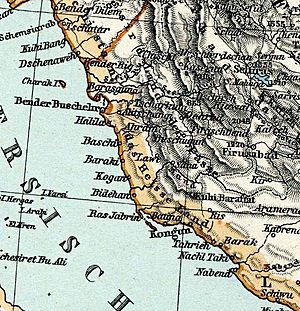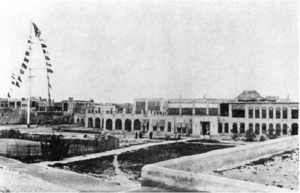British occupation of Bushehr facts for kids
Quick facts for kids British occupation of Bushehr |
|||||||
|---|---|---|---|---|---|---|---|
| Part of Persian campaign (World War I) | |||||||
 The map of the occupied area taken from the map of Iran and Turan in the Qajar period |
|||||||
|
|||||||
| Belligerents | |||||||
|
|||||||
| Commanders and leaders | |||||||
| Units involved | |||||||
|
|
||||||
| Strength | |||||||
|
Iranian boats:
|
British Equipments:
|
||||||
| Iran had officially declared neutrality in the World War I. | |||||||
The British occupation of Bushehr refers to three times when British forces took control of Bushehr, a port city in Iran. This happened during the time of the Qajar dynasty, both before and during World War I. These events show how important Bushehr was to Britain and how local Iranians fought back.
Contents
Why Bushehr Was Important to Britain
Bushehr was a very important port for trade. Since 1763, the East India Company, a big British trading company, had a base there. They used Bushehr to trade goods.
Later, there were some problems with Karim Khan Zand, who ruled Iran. So, the British moved their business to another port called Basra. But when Karim Khan Zand captured Basra, the British returned to Bushehr in 1778. They kept growing their influence in the Persian Gulf for about 100 years.
The First Time Britain Occupied Bushehr (1838)
The first time British forces occupied Bushehr was in 1838. This was during the rule of Mohammad Shah Qajar in Iran. A British ship arrived in Bushehr, and about 500 soldiers landed. They settled in an old part of the city called Kuti.
The British did this to pressure the Shah. They wanted him to stop attacking the city of Herat. This action made the people of Bushehr very angry. Local leaders like Bagher Khan Tangestani and Sheikh Hassan Ale-Osfoor led groups of people. They successfully forced the British to leave Bushehr.
The Second Time Britain Occupied Bushehr (1856)
In 1855, the ruler of Kandahar and Kabul, Dost Mohammad Khan, captured Herat. Herat was a city that Iran, Russia, and Britain all wanted to control. When Iran's ruler, Naser al-Din Shah Qajar, sent an army to take Herat, Britain got upset.
The British government then declared war on Iran. Because Iran didn't respond, Britain attacked Bushehr in 1856. They occupied the city to make Iran leave Herat. During this time, a religious leader named Mohammad Karim Khan Kermani encouraged people to fight back. He wrote a book called "Naseriyeh" to inspire them.
This occupation ended with the Treaty of Paris (1857) in 1857. In this treaty, Iran agreed to leave Herat and recognize Afghanistan as an independent country. After that, British troops left Bushehr.
The Third Time Britain Occupied Bushehr (1915)
For a long time, Britain was the most powerful country in the Persian Gulf because of Bushehr port. But by the late 1800s, other countries like the German Empire also became interested in Bushehr. They opened offices there to do business. Britain didn't like that Iran was trading with Germany and buying ships from them.
In 1913, a German consul named Wilhelm Wassmuss arrived in Bushehr. When World War I started in 1914, the German office became very active. Wassmuss became friends with local tribes in southern Iran, including Rais Ali Delvari. Meanwhile, Iran officially said it would stay neutral in the war.
The competition between Britain and Germany grew. It reached a peak when British forces arrested two German officials in Bushehr. The Iranian government and the people of Bushehr protested this action.
On August 8, 1915, a British army, mostly made up of British Indian Army soldiers, entered Bushehr. They came from land and sea, with help from navy ships. They announced that they were taking over Bushehr. They said that a British officer, Major Arthur Prescott Trevor, would now be in charge. The British claimed they had to do this because the Iranian government couldn't keep "order and security" in Bushehr. They also mentioned a recent attack by local tribes where British officers were killed.
This British action led to many fights by the Tangestanis people, who were helped by Wilhelm Wassmuss. One interesting thing was that the British put a special seal on stamps. It said: "Bushire Under British Occupation." These stamps were printed until the British left Bushehr in October 1915.
During this invasion, the British took away weapons from the local Iranian Gendarmerie (police). They also seized three Iranian ships in the port: the Mozaffari frigate and two armed boats named "Azerbaijan" and "Mazandaran." British forces raised their flag, the Union Flag, over the main government building in Bushehr. Fourteen people from Bushehr who protested the occupation were arrested and sent to India.
British Military Actions in Bushehr
Bushehr was a very important base for British military operations. From Bushehr, they managed their actions in Mesopotamia (modern-day Iraq) against the Ottoman Empire. Because of this, controlling Bushehr was key for the British. They made the entry points to Bushehr very strong. They built trenches, set up guard posts, placed artillery guns, and put up barbed wire to protect the city.
See also
- Capture of Ormuz
- Abadan Crisis
- Treaty of Paris (1857)
- Iran–United Kingdom relations
- British military network in Iran
- Postage stamps of Bushire under British occupation



